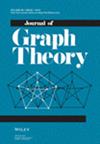双方格多图中最大匹配数的锐下限
IF 0.9
3区 数学
Q2 MATHEMATICS
Alexandr V. Kostochka, Douglas B. West, Zimu Xiang
{"title":"双方格多图中最大匹配数的锐下限","authors":"Alexandr V. Kostochka, Douglas B. West, Zimu Xiang","doi":"10.1002/jgt.23080","DOIUrl":null,"url":null,"abstract":"<p>We study the minimum number of maximum matchings in a bipartite multigraph <span></span><math>\n <semantics>\n <mrow>\n <mi>G</mi>\n </mrow>\n <annotation> $G$</annotation>\n </semantics></math> with parts <span></span><math>\n <semantics>\n <mrow>\n <mi>X</mi>\n </mrow>\n <annotation> $X$</annotation>\n </semantics></math> and <span></span><math>\n <semantics>\n <mrow>\n <mi>Y</mi>\n </mrow>\n <annotation> $Y$</annotation>\n </semantics></math> under various conditions, refining the well-known lower bound due to M. Hall. When <span></span><math>\n <semantics>\n <mrow>\n <mo>∣</mo>\n <mi>X</mi>\n <mo>∣</mo>\n <mo>=</mo>\n <mi>n</mi>\n </mrow>\n <annotation> $| X| =n$</annotation>\n </semantics></math>, every vertex in <span></span><math>\n <semantics>\n <mrow>\n <mi>X</mi>\n </mrow>\n <annotation> $X$</annotation>\n </semantics></math> has degree at least <span></span><math>\n <semantics>\n <mrow>\n <mi>k</mi>\n </mrow>\n <annotation> $k$</annotation>\n </semantics></math>, and every vertex in <span></span><math>\n <semantics>\n <mrow>\n <mi>X</mi>\n </mrow>\n <annotation> $X$</annotation>\n </semantics></math> has at least <span></span><math>\n <semantics>\n <mrow>\n <mi>r</mi>\n </mrow>\n <annotation> $r$</annotation>\n </semantics></math> distinct neighbors, the minimum is <span></span><math>\n <semantics>\n <mrow>\n <mi>r</mi>\n <mo>!</mo>\n <mrow>\n <mo>(</mo>\n <mrow>\n <mi>k</mi>\n <mo>−</mo>\n <mi>r</mi>\n <mo>+</mo>\n <mn>1</mn>\n </mrow>\n <mo>)</mo>\n </mrow>\n </mrow>\n <annotation> $r!(k-r+1)$</annotation>\n </semantics></math> when <span></span><math>\n <semantics>\n <mrow>\n <mi>n</mi>\n <mo>≥</mo>\n <mi>r</mi>\n </mrow>\n <annotation> $n\\ge r$</annotation>\n </semantics></math> and is <span></span><math>\n <semantics>\n <mrow>\n <mrow>\n <mo>[</mo>\n <mrow>\n <mi>r</mi>\n <mo>+</mo>\n <mi>n</mi>\n <mrow>\n <mo>(</mo>\n <mrow>\n <mi>k</mi>\n <mo>−</mo>\n <mi>r</mi>\n </mrow>\n <mo>)</mo>\n </mrow>\n </mrow>\n <mo>]</mo>\n </mrow>\n <msubsup>\n <mo>∏</mo>\n <mrow>\n <mi>i</mi>\n <mo>=</mo>\n <mn>1</mn>\n </mrow>\n <mrow>\n <mi>n</mi>\n <mo>−</mo>\n <mn>1</mn>\n </mrow>\n </msubsup>\n <mrow>\n <mo>(</mo>\n <mrow>\n <mi>r</mi>\n <mo>−</mo>\n <mi>i</mi>\n </mrow>\n <mo>)</mo>\n </mrow>\n </mrow>\n <annotation> $[r+n(k-r)]{\\prod }_{i=1}^{n-1}(r-i)$</annotation>\n </semantics></math> when <span></span><math>\n <semantics>\n <mrow>\n <mi>n</mi>\n <mo>≤</mo>\n <mi>r</mi>\n </mrow>\n <annotation> $n\\le r$</annotation>\n </semantics></math>. When every vertex has at least two neighbors and <span></span><math>\n <semantics>\n <mrow>\n <mo>∣</mo>\n <mi>Y</mi>\n <mo>∣</mo>\n <mo>−</mo>\n <mo>∣</mo>\n <mi>X</mi>\n <mo>∣</mo>\n <mo>=</mo>\n <mi>t</mi>\n <mo>≥</mo>\n <mn>0</mn>\n </mrow>\n <annotation> $| Y| -| X| =t\\ge 0$</annotation>\n </semantics></math>, the minimum is <span></span><math>\n <semantics>\n <mrow>\n <mrow>\n <mo>[</mo>\n <mrow>\n <mrow>\n <mo>(</mo>\n <mrow>\n <mi>n</mi>\n <mo>−</mo>\n <mn>1</mn>\n </mrow>\n <mo>)</mo>\n </mrow>\n <mi>t</mi>\n <mo>+</mo>\n <mn>2</mn>\n <mo>+</mo>\n <mi>b</mi>\n </mrow>\n <mo>]</mo>\n </mrow>\n <mrow>\n <mo>(</mo>\n <mrow>\n <mi>t</mi>\n <mo>+</mo>\n <mn>1</mn>\n </mrow>\n <mo>)</mo>\n </mrow>\n </mrow>\n <annotation> $[(n-1)t+2+b](t+1)$</annotation>\n </semantics></math>, where <span></span><math>\n <semantics>\n <mrow>\n <mi>b</mi>\n <mo>=</mo>\n <mo>∣</mo>\n <mi>E</mi>\n <mrow>\n <mo>(</mo>\n <mi>G</mi>\n <mo>)</mo>\n </mrow>\n <mo>∣</mo>\n <mo>−</mo>\n <mn>2</mn>\n <mrow>\n <mo>(</mo>\n <mrow>\n <mi>n</mi>\n <mo>+</mo>\n <mi>t</mi>\n </mrow>\n <mo>)</mo>\n </mrow>\n </mrow>\n <annotation> $b=| E(G)| -2(n+t)$</annotation>\n </semantics></math>. We also determine the minimum number of maximum matchings in several other situations. We provide a variety of sharpness constructions.</p>","PeriodicalId":16014,"journal":{"name":"Journal of Graph Theory","volume":"106 3","pages":"525-555"},"PeriodicalIF":0.9000,"publicationDate":"2024-03-03","publicationTypes":"Journal Article","fieldsOfStudy":null,"isOpenAccess":false,"openAccessPdf":"","citationCount":"0","resultStr":"{\"title\":\"Sharp lower bounds for the number of maximum matchings in bipartite multigraphs\",\"authors\":\"Alexandr V. Kostochka, Douglas B. West, Zimu Xiang\",\"doi\":\"10.1002/jgt.23080\",\"DOIUrl\":null,\"url\":null,\"abstract\":\"<p>We study the minimum number of maximum matchings in a bipartite multigraph <span></span><math>\\n <semantics>\\n <mrow>\\n <mi>G</mi>\\n </mrow>\\n <annotation> $G$</annotation>\\n </semantics></math> with parts <span></span><math>\\n <semantics>\\n <mrow>\\n <mi>X</mi>\\n </mrow>\\n <annotation> $X$</annotation>\\n </semantics></math> and <span></span><math>\\n <semantics>\\n <mrow>\\n <mi>Y</mi>\\n </mrow>\\n <annotation> $Y$</annotation>\\n </semantics></math> under various conditions, refining the well-known lower bound due to M. Hall. When <span></span><math>\\n <semantics>\\n <mrow>\\n <mo>∣</mo>\\n <mi>X</mi>\\n <mo>∣</mo>\\n <mo>=</mo>\\n <mi>n</mi>\\n </mrow>\\n <annotation> $| X| =n$</annotation>\\n </semantics></math>, every vertex in <span></span><math>\\n <semantics>\\n <mrow>\\n <mi>X</mi>\\n </mrow>\\n <annotation> $X$</annotation>\\n </semantics></math> has degree at least <span></span><math>\\n <semantics>\\n <mrow>\\n <mi>k</mi>\\n </mrow>\\n <annotation> $k$</annotation>\\n </semantics></math>, and every vertex in <span></span><math>\\n <semantics>\\n <mrow>\\n <mi>X</mi>\\n </mrow>\\n <annotation> $X$</annotation>\\n </semantics></math> has at least <span></span><math>\\n <semantics>\\n <mrow>\\n <mi>r</mi>\\n </mrow>\\n <annotation> $r$</annotation>\\n </semantics></math> distinct neighbors, the minimum is <span></span><math>\\n <semantics>\\n <mrow>\\n <mi>r</mi>\\n <mo>!</mo>\\n <mrow>\\n <mo>(</mo>\\n <mrow>\\n <mi>k</mi>\\n <mo>−</mo>\\n <mi>r</mi>\\n <mo>+</mo>\\n <mn>1</mn>\\n </mrow>\\n <mo>)</mo>\\n </mrow>\\n </mrow>\\n <annotation> $r!(k-r+1)$</annotation>\\n </semantics></math> when <span></span><math>\\n <semantics>\\n <mrow>\\n <mi>n</mi>\\n <mo>≥</mo>\\n <mi>r</mi>\\n </mrow>\\n <annotation> $n\\\\ge r$</annotation>\\n </semantics></math> and is <span></span><math>\\n <semantics>\\n <mrow>\\n <mrow>\\n <mo>[</mo>\\n <mrow>\\n <mi>r</mi>\\n <mo>+</mo>\\n <mi>n</mi>\\n <mrow>\\n <mo>(</mo>\\n <mrow>\\n <mi>k</mi>\\n <mo>−</mo>\\n <mi>r</mi>\\n </mrow>\\n <mo>)</mo>\\n </mrow>\\n </mrow>\\n <mo>]</mo>\\n </mrow>\\n <msubsup>\\n <mo>∏</mo>\\n <mrow>\\n <mi>i</mi>\\n <mo>=</mo>\\n <mn>1</mn>\\n </mrow>\\n <mrow>\\n <mi>n</mi>\\n <mo>−</mo>\\n <mn>1</mn>\\n </mrow>\\n </msubsup>\\n <mrow>\\n <mo>(</mo>\\n <mrow>\\n <mi>r</mi>\\n <mo>−</mo>\\n <mi>i</mi>\\n </mrow>\\n <mo>)</mo>\\n </mrow>\\n </mrow>\\n <annotation> $[r+n(k-r)]{\\\\prod }_{i=1}^{n-1}(r-i)$</annotation>\\n </semantics></math> when <span></span><math>\\n <semantics>\\n <mrow>\\n <mi>n</mi>\\n <mo>≤</mo>\\n <mi>r</mi>\\n </mrow>\\n <annotation> $n\\\\le r$</annotation>\\n </semantics></math>. When every vertex has at least two neighbors and <span></span><math>\\n <semantics>\\n <mrow>\\n <mo>∣</mo>\\n <mi>Y</mi>\\n <mo>∣</mo>\\n <mo>−</mo>\\n <mo>∣</mo>\\n <mi>X</mi>\\n <mo>∣</mo>\\n <mo>=</mo>\\n <mi>t</mi>\\n <mo>≥</mo>\\n <mn>0</mn>\\n </mrow>\\n <annotation> $| Y| -| X| =t\\\\ge 0$</annotation>\\n </semantics></math>, the minimum is <span></span><math>\\n <semantics>\\n <mrow>\\n <mrow>\\n <mo>[</mo>\\n <mrow>\\n <mrow>\\n <mo>(</mo>\\n <mrow>\\n <mi>n</mi>\\n <mo>−</mo>\\n <mn>1</mn>\\n </mrow>\\n <mo>)</mo>\\n </mrow>\\n <mi>t</mi>\\n <mo>+</mo>\\n <mn>2</mn>\\n <mo>+</mo>\\n <mi>b</mi>\\n </mrow>\\n <mo>]</mo>\\n </mrow>\\n <mrow>\\n <mo>(</mo>\\n <mrow>\\n <mi>t</mi>\\n <mo>+</mo>\\n <mn>1</mn>\\n </mrow>\\n <mo>)</mo>\\n </mrow>\\n </mrow>\\n <annotation> $[(n-1)t+2+b](t+1)$</annotation>\\n </semantics></math>, where <span></span><math>\\n <semantics>\\n <mrow>\\n <mi>b</mi>\\n <mo>=</mo>\\n <mo>∣</mo>\\n <mi>E</mi>\\n <mrow>\\n <mo>(</mo>\\n <mi>G</mi>\\n <mo>)</mo>\\n </mrow>\\n <mo>∣</mo>\\n <mo>−</mo>\\n <mn>2</mn>\\n <mrow>\\n <mo>(</mo>\\n <mrow>\\n <mi>n</mi>\\n <mo>+</mo>\\n <mi>t</mi>\\n </mrow>\\n <mo>)</mo>\\n </mrow>\\n </mrow>\\n <annotation> $b=| E(G)| -2(n+t)$</annotation>\\n </semantics></math>. We also determine the minimum number of maximum matchings in several other situations. We provide a variety of sharpness constructions.</p>\",\"PeriodicalId\":16014,\"journal\":{\"name\":\"Journal of Graph Theory\",\"volume\":\"106 3\",\"pages\":\"525-555\"},\"PeriodicalIF\":0.9000,\"publicationDate\":\"2024-03-03\",\"publicationTypes\":\"Journal Article\",\"fieldsOfStudy\":null,\"isOpenAccess\":false,\"openAccessPdf\":\"\",\"citationCount\":\"0\",\"resultStr\":null,\"platform\":\"Semanticscholar\",\"paperid\":null,\"PeriodicalName\":\"Journal of Graph Theory\",\"FirstCategoryId\":\"100\",\"ListUrlMain\":\"https://onlinelibrary.wiley.com/doi/10.1002/jgt.23080\",\"RegionNum\":3,\"RegionCategory\":\"数学\",\"ArticlePicture\":[],\"TitleCN\":null,\"AbstractTextCN\":null,\"PMCID\":null,\"EPubDate\":\"\",\"PubModel\":\"\",\"JCR\":\"Q2\",\"JCRName\":\"MATHEMATICS\",\"Score\":null,\"Total\":0}","platform":"Semanticscholar","paperid":null,"PeriodicalName":"Journal of Graph Theory","FirstCategoryId":"100","ListUrlMain":"https://onlinelibrary.wiley.com/doi/10.1002/jgt.23080","RegionNum":3,"RegionCategory":"数学","ArticlePicture":[],"TitleCN":null,"AbstractTextCN":null,"PMCID":null,"EPubDate":"","PubModel":"","JCR":"Q2","JCRName":"MATHEMATICS","Score":null,"Total":0}
引用次数: 0
摘要
我们研究了具有部分 和 的双方形多图在各种条件下的最大匹配数的最小值,完善了霍尔(M. Hall)提出的著名下界。当 ,中的每个顶点都至少有度 ,且每个顶点都至少有不同的邻居时,最小匹配数为 ,且 为 。当每个顶点至少有两个邻居且 时,最小值为 ,其中 。我们还确定了其他几种情况下最大匹配数的最小值。我们提供了多种锐度构造。本文章由计算机程序翻译,如有差异,请以英文原文为准。
Sharp lower bounds for the number of maximum matchings in bipartite multigraphs
We study the minimum number of maximum matchings in a bipartite multigraph with parts and under various conditions, refining the well-known lower bound due to M. Hall. When , every vertex in has degree at least , and every vertex in has at least distinct neighbors, the minimum is when and is when . When every vertex has at least two neighbors and , the minimum is , where . We also determine the minimum number of maximum matchings in several other situations. We provide a variety of sharpness constructions.
求助全文
通过发布文献求助,成功后即可免费获取论文全文。
去求助
来源期刊

Journal of Graph Theory
数学-数学
CiteScore
1.60
自引率
22.20%
发文量
130
审稿时长
6-12 weeks
期刊介绍:
The Journal of Graph Theory is devoted to a variety of topics in graph theory, such as structural results about graphs, graph algorithms with theoretical emphasis, and discrete optimization on graphs. The scope of the journal also includes related areas in combinatorics and the interaction of graph theory with other mathematical sciences.
A subscription to the Journal of Graph Theory includes a subscription to the Journal of Combinatorial Designs .
×
引用
GB/T 7714-2015
复制
MLA
复制
APA
复制
导出至
BibTeX
EndNote
RefMan
NoteFirst
NoteExpress
请完成安全验证×
微信好友
朋友圈
QQ好友
复制链接
取消

已复制链接
快去分享给好友吧!
我知道了

点击右上角分享
相关文献
 求助内容:
求助内容: 应助结果提醒方式:
应助结果提醒方式:
